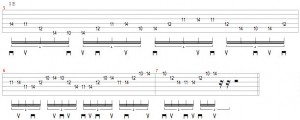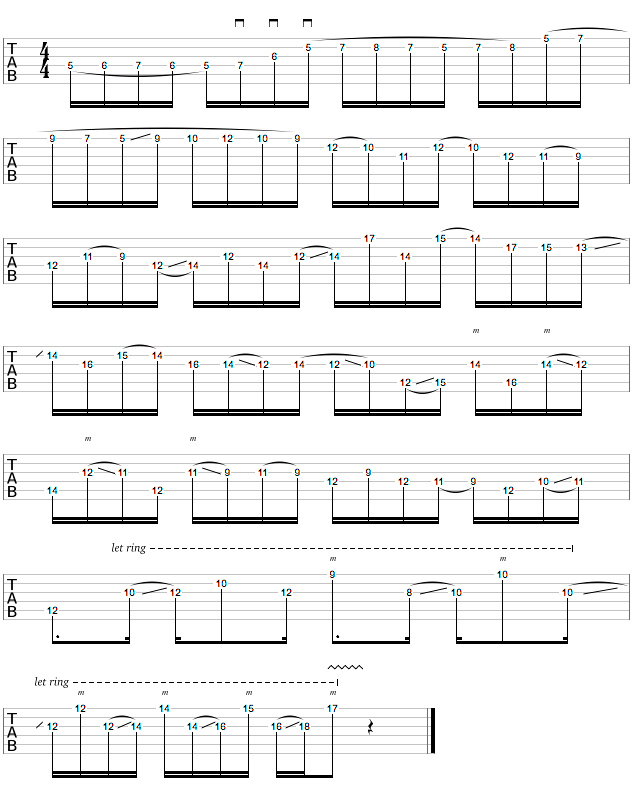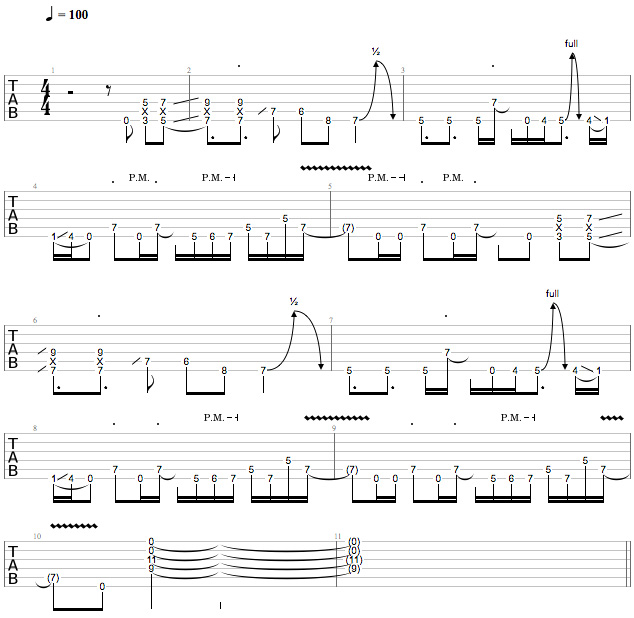Welcome to my third column/lesson. This time I’d like to talk a little bit about diminished scales/arpeggios with their possible application solos. Knowing how to use a diminished “idea” represents a very powerful tool to create moments of musical tension.
A diminished/octatonic scale is a symmetrical scale (whose intervallic relationship is symmetrical) composed of 8 notes. There are 2 modes of a given diminished/octatonic set: whole/half/whole/half and so on, or half/whole/half/whole and so on. It’s a very easy scale to use on an instrument like the guitar, because even though there are 8 notes in it, there are only two positions to learn on the neck of the guitar. At the same time, consider how it is possible to expand such a scale in a variety of musical applications. To achieve this, let us look at a few examples taken directly from players that I admire.
Example 1:
The first example is from a song called “The River Dragon Has Come” by Nevermore (Dead Heart in a Dead World/2000). It’s a perfect example of how a simple Diminished idea can be replicated across the neck to create a moment of musical tension and an extremely dark and unresolving atmosphere. The rhythm is simply a stream of 16th notes; the accents highlight the weak beats, which in turn create a sense of suspension that perfectly matches with the contrasting rhythm guitar track.
Even if it’s not a “fast” lick per se, it requires attention to be performed accurately and with conviction – it is not easy to keep a steady sense of pulse/time in tempo. This part of the solo repeats itself for a second time, but it moves down chromatically (a half step). After these first 8 bars a second lead guitar enters the fray, harmonizing the lick a minor third down. In regards to mechanics, the lick involves both alternate and sweep picking, making this an excellent work out for both techniques.
Nevermore – The River Dragon Has Come
1

Example 2:
The second example is taken from the song “Soul Burn” by Meshuggah – from the album Destroy Erase Improve/1995. This example represents a very different approach from the one analyzed previously, both in regards to its rhythmic properties and its use of the Octatonic Scale (aka Diminished Scale). The first 4 notes (C Gb Bb E) are taken from a Whole Tone Scale and are the only notes/phrases that do not conform to the diminished/octatonic set in this part of the solo.
Starting from measure 3 we have the whole thing based on these notes (C# D E F G Ab Bb B), which is a C# Octatonic Scale – the rest of the solo we will analyze here corresponds to this set. The most interesting aspect of this solo is without a doubt distinguished by its use of syncopation and a diverse array of rhythmic cells. Pay attention to where the notes fall, and to the clever use of rests to build tension and to give breathing room to the lines being executed. For this example, I decided to record with a clean tone, and attempted to get a quasi-synthaxe sound. I felt compelled to use this tone because it reminds me of one of my favorite guitar players…I will let you guess who!
Meshuggah – Soul Burn
2



Example 3:
The third and last example is a small “Etude” I wrote, putting together some of my favorite Diminished ideas. It starts with a Diminished arpeggio position I really love and I feel comfortable with (measure 1-7) moving chromatically down a half step in measure 2 and again in measure 4. The second idea (measure 8-12) is a more traditional 3 notes per string in minor-thirds, with some string skipping and some slides/slurs. The third idea is still based on 3 notes per string fingerings, but it uses different intervals and has more extreme string skipping in it. The groups of notes I play are 11 and 17, with some slides/slurs and some chromatic (up a half step) motion.
This idea is connected with the next one in measure 21 where I go back to the minor-third-intervals concept and it continues with a more traditional slide/arpeggio line that ends on measure 25. Measure 26 is based on the same arpeggio idea I used in the beginning, but it is expanded throughout the whole fret board with a huge slide. In this case I tend to keep the rhythm very free, quasi-rubato, trying not to sound rigid awhile attempting to make it as musical as possible (let it breathe!). I played this example with a clean tone to get a “cleaner” sound and to make every note come out with more definition, attempting to articulate everything as well as I could.
This small “Etude” definitely does not represent a great piece of music, but it serves as a great Diminished workout; including many ideas which lead to the further development of one’s technique, dexterity, and confidence in regards to tricky fingerings. I hope you enjoyed it and stay tuned for part #2!
Diminished Etude – by Francesco Artusato
3




















